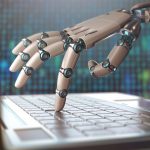A professional book illustrator has backed out of hosting a masterclass at the Bradford Literature Festival after the festival used AI art in its promotion.
Artists vs AI
Chris Mould, 54, from Bradford, said he was not aware of the festival’s use of AI-generated publicity images until he was ‘called out’ for supporting the festival.
Mr Mould then looked into the matter further, asking someone at the festival to confirm if the images were AI-generated.
When they confirmed they were made by AI, Chris immediately announced he would be pulling out.
He said: “My issue was how can I stand under their roof and tell people they can go to art school and work in these disciplines if the material used to publicise that event is generated at the push of a button?”
Chris’s withdrawal will come as a blow to the festival, where Lenny Henry amongst others will be attending from 23rd June to 2nd July.
Chris is most known for creating artwork for Matt Haig’s children’s books.
Nicola Solomon, chief executive of The Society of Authors (SoA), wrote to Syima Aslam, director of the festival, to voice her concerns. She said she was “extremely disappointed” that the festival, a main stage for arts and culture, was using AI-generated images.
She was invited to discuss further what was described as a “complex issue”.
Ms Aslam also said the festival used a local design agency to work on the campaign and that it “should have been more explicit about the use of AI tools and the potential issues that this entailed”.
What’s Wrong With Artificial Art?
AI art generators use machine learning algorithms and deep neural networks to create images. They learn patterns and styles from large sets of pre-made art to create ‘new’ art.
There are perhaps three major concerns with AI-generated art in this regard.
One is its very use of pre-made art to create images. AI is only as good as the data it’s trained on, which is human creations. Therefore, many artists feel AI-generated art is a form of plagiarism.
Another issue is the lack of human labour and skill involved in creating the art. Many people appreciate the time, craftsmanship and consideration that goes into human art and that this gives it value.
Finally, AI-generated art lacks its own intrinsic link to a human being. Many people feel connected to art through shared emotions and experiences, inspirations and motivations behind it. Without this, people may feel the art fundamentally lacks meaning.
How AI Could Benefit Artists
AI tools could provide artists with several advantages. One of which helping artists save time and streamline their creative processes.
They could automate repetitive tasks such as rendering or colour correction, allowing artists to put more focus on the creative process.
AI could help artists generate new ideas and concepts, providing them with a new source of inspiration from which they can add their own unique style.
AI art tools could also help artists with limited capabilities apply their ideas and produce high-quality work.
From an education perspective, AI tools could also provide guidance and suggestions to artists, helping them to improve their technique and produce more polished work.
This could be especially beneficial for freelancers and artists who may need access to a mentor or tutor.
Could AI Art Take Over?
Until AI is able to create unique ideas from scratch and explain the meaning behind them, it is unlikely it will fully replace artists anytime soon.
And because AI does not yet have a soul or personality, many people believe it could never match the ability to express itself as humans can.
However, if AI-generated work becomes the norm, it could lead to a homogenisation of the creative industry. Many fear that this could stifle individual expression and diversity.
Where would this then leave skilled humans who have trained for years, if not decades in their chosen craft?
Conclusion
The impact of AI systems on the arts, entertainment, creatives and society is complex and multifaceted.
There are many concerns over its threat to devalue art, but there are also many ways it could support and elevate artists on a technical and educational level.
The Bradford Literature Festival controversy, therefore, highlights some key lessons to be learnt in the emergence of AI art.
Regulations are needed to ensure maximum benefits and minimum damages for artists, while protecting and preserving art to be enjoyed by everybody.
However, if artists like Chris Mould continue to drop out in protest of AI, who will be left in to stand against the machines?
Keep up to date with all the latest AI news here.












